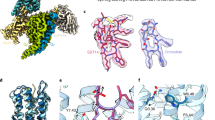Abstract
Radioligand binding studies were performed in membranes of human cerebral cortex using [125I]Tyr3-octreotide in the presence of 5 mM MgCl2, [125I]SRIF-14 ([125I]Tyr11-SRIF-14) and [125I]CGP 23996 ([125I]c[Asu-Lys-Asn-Phe-Phe-Trp-Lys-Thr-Tyr-Thr-Ser]) both in the presence of 120 mM NaCl, to characterise the nature of the somatostatin (SRIF) receptors. The pharmacological profile of human brain SRIF recognition sites was compared with that of recombinant human SRIF1 (sst2-sst3-sst5) or SRIF2 receptors (sst1-sst4) and with that of native rat sst1, sst2 and sst4 receptors.
[125I]Tyr3-octreotide labelled binding sites in human cerebral cortex: B max = 238 ± 36 fmol/mg protein and pKd = 9.73 ± 0.08. The pharmacological profile of [125I]Tyr3-octreotide labelled sites correlated very significantly with that of recombinant human sst2 receptors (r = 0.98) and much less with those of recombinant human sst3 (r = 0.65) or sst5 receptors (r = 0.72). The correlation between [125I]Tyr3-octreotide binding to native sst2 receptors in human and rat cerebral cortex was also highly significant (r = 0.97). [125I]SRIF-14 and [125I]CGP 23996 binding (performed in the presence of 120 mM NaCl) in the human cerebral cortex identified very similar populations of sites B max = 44 ± 7 and 36 ± 5 fmol/mg protein and pKd = 9.44 ± 0.08 and 9.48 ± 0.10, respectively. The pharmacological profiles of the sites labelled with [125I]SRIF-14 and [125I]CGP 23996 correlated highly significantly with those of recombinant human sst1 (r = 0.97–0.99) or sst4 receptors (r = 0.91–0.94). Similarly, the correlations between [125I]SRIF-14 or [125I]CGP 23996 binding in human cortex and [125I]SRIF-14 binding to native sst1 sites in rat cerebral cortex were also highly significant (r = 0.97 and 0.94, respectively). Finally, the pharmacological profile of native rat lung sst4 sites determined with [125I]LTT-SRIF-28 ([Leu8,D-Trp22,125I-Tyr25]SRIF-28) correlated with [125I]SRIF-14 and [125I]CGP 23996 binding in human cortex; r = 0.91 and 0.87, respectively.
The present data show that in human cerebral cortex, [125I]Tyr3-octreotide labels SRIF1 receptor sites which are best characterised as of the sst2 type, whereas [125I]SRIF-14 and [125I]CGP 23996 (both in the presence of 120 mM NaCl), label sites which fit almost equally well with sst1 or sst4 receptors and therefore are best described as of the SRIF2 type. Under the conditions used, there was no evidence that either of these ligands would label sst3 or sst5 receptors in human cerebral cortex.
Similar content being viewed by others
Author information
Authors and Affiliations
Additional information
Received: 8 August 1996 / Accepted: 8 November 1996
Rights and permissions
About this article
Cite this article
Piwko, C., Thoss, V., Schüpbach, E. et al. Pharmacological characterisation of human cerebral cortex somatostatin SRIF1 and SRIF2 receptors. Naunyn-Schmiedeberg's Arch Pharmacol 355, 161–167 (1997). https://doi.org/10.1007/PL00004927
Issue Date:
DOI: https://doi.org/10.1007/PL00004927




